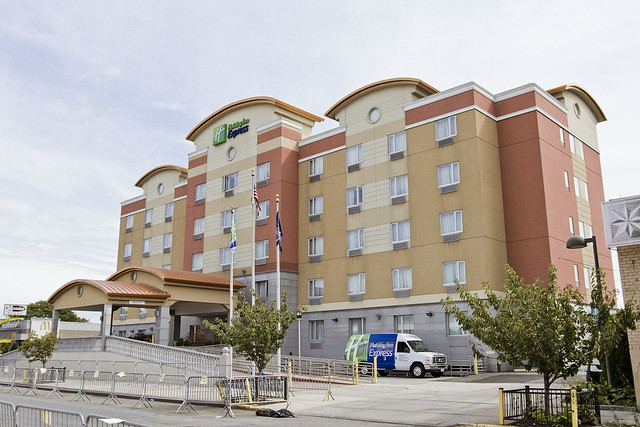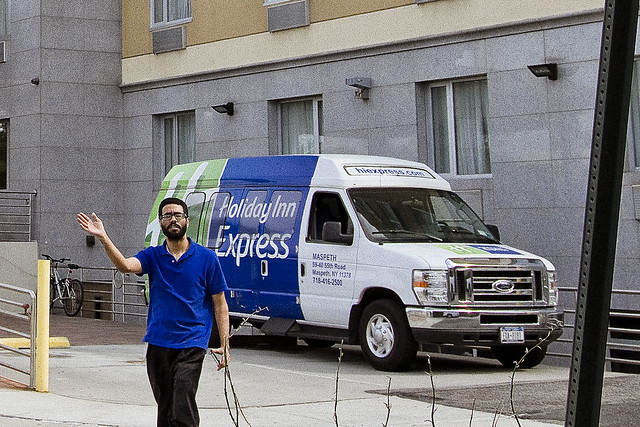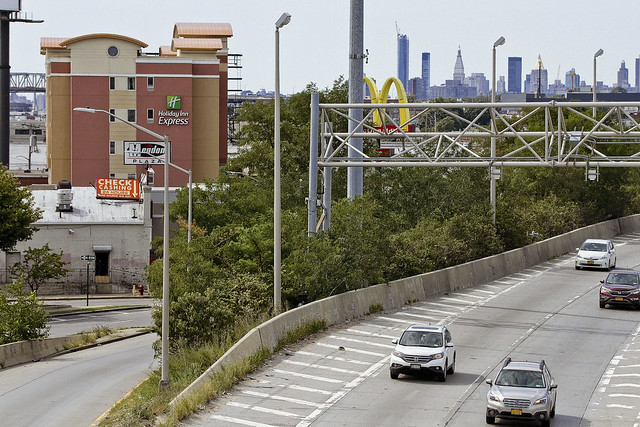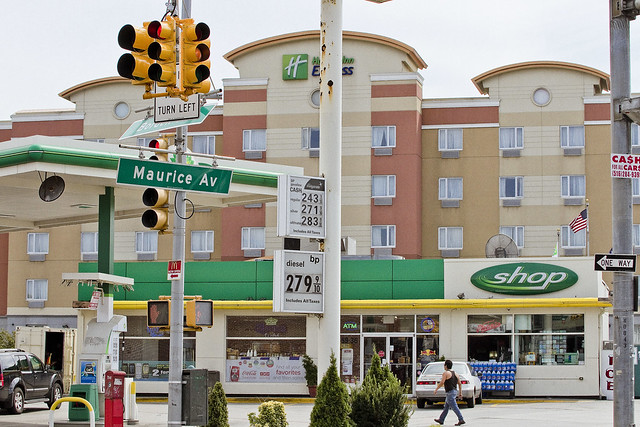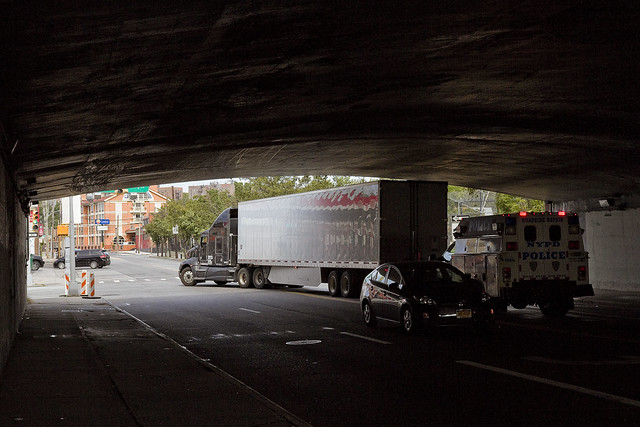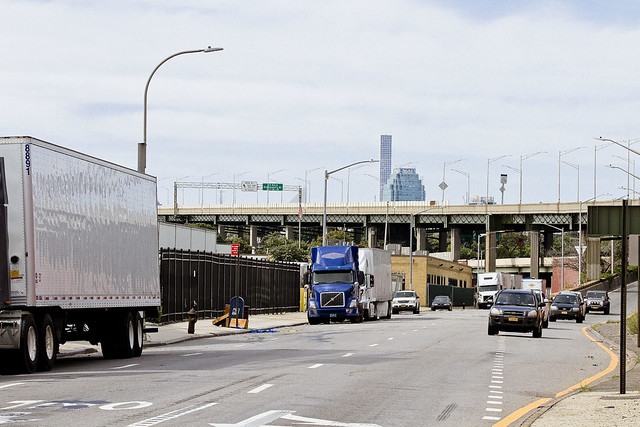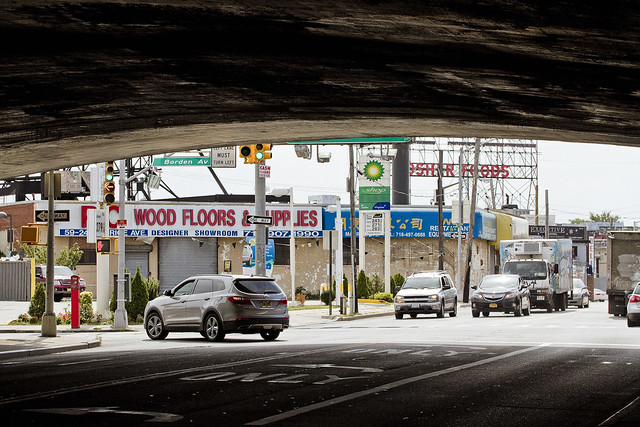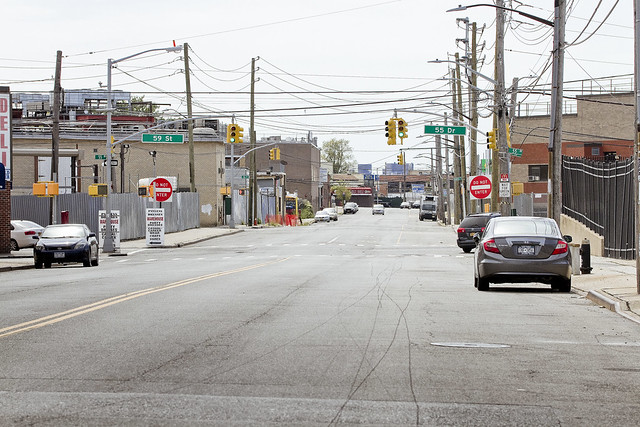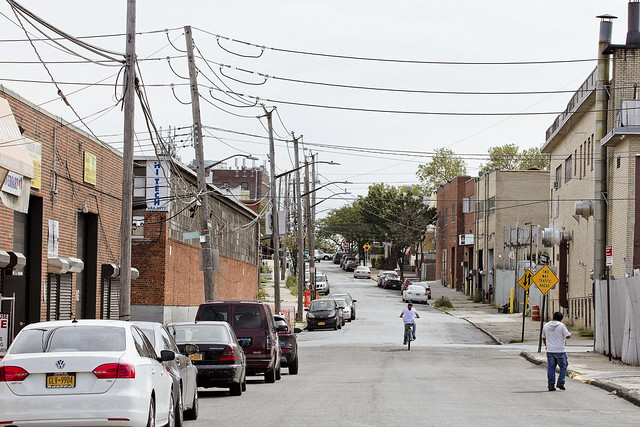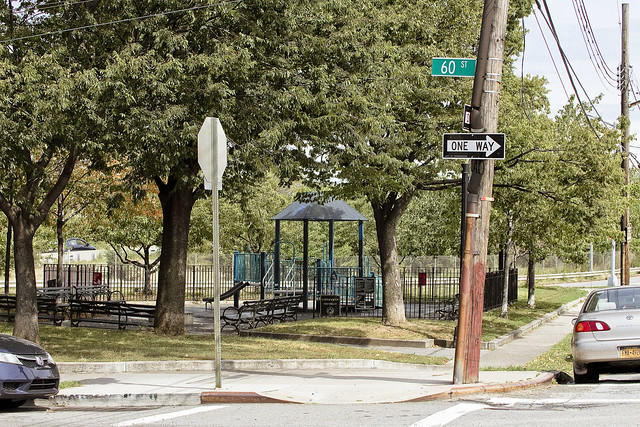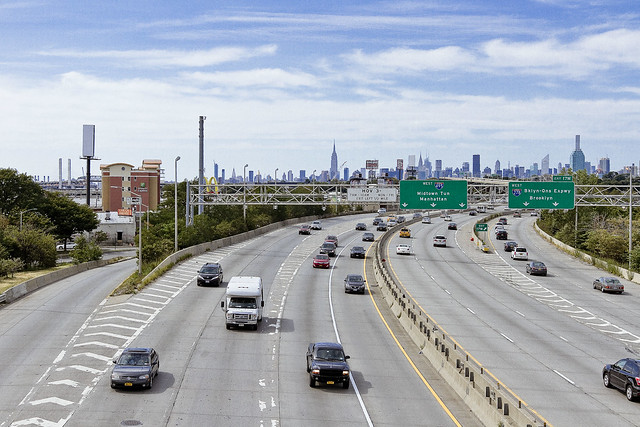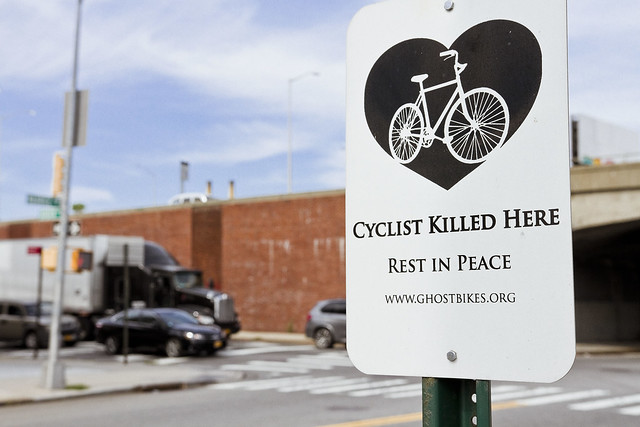Posts Tagged ‘homeless’
obvious that
More on the proposed Maspeth Homeless Shelter.
– photo by Mitch Waxman
In yesterday’s post, the northern side of the area surrounding the proposed Homeless Shelter in Maspeth was descirbed in somewhat excruciating detail. The proposal put forward from the Mayor’s office calls for converting a Holiday Inn hotel on 55th Road to provide housing for one of NYC’s most vulnerable groups of people, and the location of it seems to be an entirely random choice of venue which City Hall arrived at by throwing a dart at a map of districts which didn’t support the Mayor in the last election cycle. The decision has already caused one long serving local politician to lose her job in an elective primary to an upstart and relative unknown who strongly objects to the placement of this facility, something which I’m sure the political establishment hereabouts will hold against the “Dope from Park Slope” when he attempts to get reelected.
That’s the hotel in the shot above, the tan and coral structure just to the south of the Long Island Expressway.
– photo by Mitch Waxman
Other than being a bland architectural travesty, the hotel itself is inoffensive. As a note, there is another nearby hotel found to the north on Maurice Avenue across the street from Mt. Zion cemetery – a Comfort Inn branded establishment which, like the Holiday Inn pictured above, exploits the European tourist market and offers lodging at a rate significantly lower than the ones offered at hotels closer to the City center. The shot above is from 55th Road, by the way.
– photo by Mitch Waxman
While I was gathering these shots, the fellow above emerged from the hotel. He first informed me that I couldn’t take photos of the structure without a permit, then kind of invaded my personal space while telling me he didn’t want his photo published in a newspaper. This is a web site, incidentally, so I would offer to the gentleman pictured above that he needs to be more specific when stating his prohibitions. I reminded him that I was on the sidewalk of an adjoining property, of course, and that he had no right to attempt to circumnavigate the constitution of these United States on the subject of photography of those things which are visible from the sidewalk. He also sundered his right to privacy by confronting me thusly. Were I assigning any sort of editorial “slant” to this photo, he would have a legitimate beef with me, but since I’m not – he doesn’t.
As I always say, if you don’t me to point a camera at you, don’t hassle me when I’m shooting.
– photo by Mitch Waxman
As stated in yesterday’s post, my objections to the placement of this facility revolve around the actual location of it, which I honestly believe to be a violation of the human rights of a vulnerable population.
The Holiday Inn sits across the street from the Long Island Expressway, which produces a standing wall of high decibel sound. While I was shooting the shot above, I actually called a friend, whom I could not hear even though my headphones were in – and she could barely make out what I was saying despite the fact that I was shouting into the microphone.
– photo by Mitch Waxman
This gas station with a convenience store is directly across the street from the hotel, and would presumptively fill the role of a supermarket for purchasing food and other existential necessaries. As is the case with such locations, everything you can purchase within is priced as high as the market will bear, and food items available are typically highly processed food stuffs designed for a long shelf life.
I guess the Mayor thinks that microwave burritos are good enough for these so called “Homeless” he’s planning on exiling to industrial Maspeth.
– photo by Mitch Waxman
The character of the streets surrounding the hotel can be best described as truck routes. The sidewalks found under the overpasses of the highway have no pedestrian protections like bollards or jersey barriers, and are littered with debris and dead pigeons. There is no lighting, and perpetual shadow exists down in these spaces.
– photo by Mitch Waxman
To the west – more highways, cemeteries, and industrial sprawl.
– photo by Mitch Waxman
To the south – the roads lead to the industrial zone surrounding the Newtown Creek superfund site.
– photo by Mitch Waxman
To the east – McDonalds and a Chinese take out restaurant offers an alternative food source to the microwaved burritos and packaged snack cakes found at the gas station convenience store. Luckily, there’s a financial institution in this little strip mall – a check cashing location, which like all examples of such institutions offers high interest payday loans and charges a usurious amount for cashing a check.
The people proposed for exile to this hotel are going to need somewhere to cash their benefit checks, after all, why not ensure that they get to keep as little of it as possible?
– photo by Mitch Waxman
Looking south – up Maurice Avenue. At the top of the hill, around a half mile away, is the Goodfellas/Clinton Diner on Rust Street, if you need a landmark. The businesses located in the area are mainly warehouse operations, and there’s still a bit of manufacturing going on in the area, but it’s highly unlikely that any of the businesses in this area would hire a down on their luck person for an entry level job.
– photo by Mitch Waxman
Pictured above is 55th drive, looking east, this street is found behind the hotel property lot. Bleak, this is an industrial street which hosts a few Korean family owned kitchen cabinet manufacturers and a couple of warehouse operations. During the week – the fleets of trucks which carry their wares, and palettes of their products, populate roadway and sidewalk alike.
– photo by Mitch Waxman
Looking west along 55th drive, the Koscisuzcko Bridge project is visible, but I don’t think that an opportunity for work will manifest itself for the proposed occupants of the Holiday Inn hotel there either.
What are the people that the City wants to move in here supposed to do to fill their days?
– photo by Mitch Waxman
The condition of the sidewalks and streets along 55th drive are fairly crappy. As with all the industrial neighborhood sidewalks you’ll find in Western Queens – illegally dumped junk, debris, and gravel are randomly deposited.
– photo by Mitch Waxman
This playground and pocket park is one of the very few public green spaces in Maspeth’s northern section, and will likely become the place where the residents of the Hotel spend their time.
– photo by Mitch Waxman
So, does it make sense?
Is it smart to exile a vulnerable population in an industrial zone found along an elevated highway that carries close to a half million vehicle trips a day and which produces an ear shattering din? Is it ok for these people to be exploited by a check cashing location, and to have to make a choice between eating convenience store food, Chinese take out, or at McDonalds? Or, is it just expedient?
Spotty bus service is a regular complaint for the residents of the surrounding neighborhood, and Maspeth is notoriously a “transit desert.” How will the people housed in this Holiday Inn access medical or social services without a car?
– photo by Mitch Waxman
What do you think?
Upcoming tours and events:
“The Untold History of the Newtown Creek (aka Insalubrious Valley)” walking tour
with New York Adventure Club, Saturday, October 1st from 11:00 a.m. to 1:00 p.m.
Click here for tickets.
“First Calvary Cemetery” walking tour
with Brooklyn Brainery, Saturday, October 8th from 11:00 a.m. to 1:00 p.m.
Click here for tickets.
“follow” me on Twitter- @newtownpentacle
inexplicably weaker
Today’s posting comes direct to you from Astoria, Queens.
– photo by Mitch Waxman
Just a short posting today, a couple of scenes recently recorded here amongst the blessed slopes of raven tressed Astoria. The couple shown in the shot above were observed on Steinway Street, taking an afternoon nap on one of the many new benches recently installed. Scenes reminiscent of the one above are the reason that the Koch administration removed this form of street furniture around the City in the first place, back in the 1980’s, as I recall.
– photo by Mitch Waxman
Strongly contrasting with the first shot is this amazing hot rod Corvette parked just a few blocks away nearby Northern Blvd. Upon observation of this well appointed automobile, a humble narrator began to gibber and jump with acrimony over the fact that it is not his. It is high time that I have a midlife crisis, and this car would fit the bill for my last grasping attempts at youthful abandon. I would call it the Mitchmobile, and would be heard loudly and atonally singing “na na na Na Na, Wax-man” whilst touring the Newtown Creek at a thousand miles per hour.
Want to see something cool? Summer 2013 Walking Tours-
The Insalubrious Valley– Saturday, June 29, 2013
Newtown Creek walking tour with Mitch Waxman and Newtown Creek Alliance, tickets now on sale.
Modern Corridor- Saturday, July 13, 2013
Newtown Creek walking tour with Mitch Waxman and Atlas Obscura, tickets on sale soon.
little memories
– photo by Mitch Waxman
The thing I like about walking the earth is that one moves at a slow pace, and it’s possible to notice the little things otherwise obscured by vehicular speed which line the streets of the great metropolitan city. Whether it be an altar following the precepts of some cultic faith, or the odd things which might be observed at the fence lines of area cemeteries, or just the footpath leading to a homeless camp- these small details are obscured by speed. This phenomena first became apparent to me when still a teenager, before the hellish green flame of revelation was lit in my mind.
– photo by Mitch Waxman
For many years, just where the high flying Queens Midtown Expressway returns vehicular traffic to ground at Greenpoint Avenue and it transmogrifies into the Long Island Expressway, behind one of the ramps that lead from VanDam, there was a long established and quite populous homeless camp. As an aside, I should mention that your humble narrator has a scary rapport with these often debased, dangerous, and diabolical men (few women take up residence in these places, I’ve observed) which has caused me no small amount of concern. Personal experience and the social class which I was born into (working class, there was always plenty to eat, and Dad owned a car) would normally preclude any interaction at all with such vagabonds (called Bums up till sometime in the mid 80’s), but for some reason, “the street” and I understand each other. The stories told by such men, often told in return for a hip pocket flask of cheap libation, reveal a side of our community which won’t be recorded by history.
– photo by Mitch Waxman
The camp at this location has recently been swept out, no doubt due to the attentions of the NYPD and certain policies enacted by the City Fathers in Manhattan designed to offer proper shelter to a vulnerable and often mentally ill population in need of doctoring. Such progressive policies are the responsible and “Christian” thing to do, of course, as those of us who manage to claw our way through the dark and find purchase on the socioeconomic ladder are presented with the moral quandary of helping those who cannot. My experience with the homeless, though, is that by and large it’s not “cannot” – it’s “will not”. When I lived on what is now called the “Upper West Side” in Manhattan, my pal Henry whose last address was a car parked alongside Needle Park once told me that the tramps had their own world with certain social hierarchies, and were the true New Yorkers. Another unfortunate, Raggedy Andy, described interaction with “the world” as painful for him- he preferred the life of the streets to the rote and obligations presented to him by the “do gooders”, social workers, and the nemesis gendarme.
– photo by Mitch Waxman
All that remains to indicate their morbid habitation is a cooking pan, several dog eared books, and the soiled bedding which typifies such ad hoc agglutinate communities. Encounters with these men, while dangerous for an unarmed visitor, have instead filled my mind with wonder. Tales from Latino day laborers along Broadway in Astoria about a white man with a strange mustache in a late model red van from whom you should never accept an offer of work, as those who go with him are never heard from again. Second hand reports from a mendicant on Grand Avenue in Maspeth about a thing which has been seen around the extant sections of English Kills, described as a sort of small dog which walks about on two legs, and descriptions of some enormous and shining black shape seen slithering around in Maspeth Creek during moonless nights have all been related to me. Obviously addled by liquor and narcotics and informed by madness, the witnesses are suspect at best, but as always, your Newtown Pentacle presents what is offered to it “as is” without varnish or judgement. One wonders though, about this burned out ancient house in Blissville- not far from Calvary Cemetery- and the secrets which might lie hidden in it’s worm eaten walls.
Kneeling upright
– photo by Mitch Waxman
The local supermarket, a Pathmark on Northern Blvd., has installed a device on its shopping carts that lock the wheels when you try to roll them off the property line. A buried wire, perhaps, or some sort of radio signal keeps the carts from distributing themselves around the neighborhood like the Home Depot and Stop n’ Shop carts that can found in basements and garages across the Newtown Pentacle. Once, this was the preferred cargo carrier for New York’s unfortunates, an uncovered wagon for the concrete prairies.
from wikipedia
Shopping cart theft can be a costly problem with stores that use them. Often the carts end up in apartment complexes, low-income housing, bus stops or locations where the person doing the shopping is unlikely to own a car. The carts, which cost between $75 and $150 each, have been used for such purposes as barbecue pits, go-carts, laundry trolleys and even shelters, or they are simply abandoned. Because such losses can be substantial (up to $800 million globally lost every year), stores have resorted to various systems to prevent theft. Stores may use one or more of these systems (i.e., cart retrieval and electronic).
Cart retrieval service
Some stores utilize a cart retrieval service, which collects carts found off the store’s premises and returns them to the store for a fee. The drawbacks of this measure include that it is reactive instead of proactive (i.e., it can only be used once a cart has been taken from the premises), can become costly, and does nothing to deter hoarders. Some retrieval services have also been caught taking carts from the store’s parking lot and turning them in as stray carts.
Electronic
Electronic systems are being increasingly used by stores because of their successful deterrence. In principle, the system is similar to electric fences that give dogs’ necks a yank when they cross an underground boundary. Each shopping cart is fitted with an electronic locking wheel, or ‘boot’. A transmitter with a thin wire is placed around the perimeter of the parking lot. The boot locks when the cart leaves the designated area. Store personnel must then deactivate the lock with a hand-held remote to return the cart to stock. Often a line is painted in front of the broadcast range to warn customers that their cart will stop when rolled past the line.
– photo by Mitch Waxman
The cheap wire shopping carts offered to perform the curb to house function today just can’t compare. The bottle and can collectors favor this sort of model, and an iteration of it is found in my own kitchen. It’s not sturdy, quite unstable, and has an incontrovertibly high center of gravity making it prone to unexpected tipping. A sudden abundance of laundry here at Pentacle HQ was instrumental in discovering its load capacity was a mere 80 pounds (don’t ask) which causes the wheels to snap off. A sturdy supermarket style cart carries an unknown, but substantially higher weight.
from nyc.gov
To ready your metal, glass and plastic containers for recycling, rinse them clean and place them in a clear bag or blue-labeled container; caps and lids should be removed. You should place paper recycling in a separate clear bag or green-labeled container and tie flattened corrugated cardboard with strong twine.
Collect glass, plastic or aluminum beverage containers with a 5-cent deposit, such as those for beer, soda and other carbonated drinks, and take them to a local grocery, deli or other store for recycling. (You can also put your redeemable cans and bottles out with your other recyclables where needy individuals may find them and turn them in for the nickel deposit.)
If you live in a building that does not recycle, contact your building manager or superintendent to set up a recycling system for tenants. You can report recycling violations anonymously online or by calling 311.
– photo by Mitch Waxman
To a veteran of the 1980’s and early 90’s iteration of New York City- when 42nd street at Times Square was called “dadeuce”- a time when endemic homeless populations ruled the streets, it is disturbing to see their population swelling again. The local Croats and Serbs refer to the village madmen as “sin eaters”, and the more august members of the community have other colorful terms to describe them. New immigrants are typically less than charitable toward such individuals, but to be fair- their perspective is that of having showed up in this country with just a suitcase and then building a life for themselves within just a few years. It is inconceivable to these new citizens to see an American who would live in such a state, when the solution to all their problems is “work”, an opportunity not available or perhaps denied in their countries of origin.
from wikipedia
The term sin-eater refers to a person who, through ritual means, would take on by means of food and drink the sins of a deceased person, thus absolving his or her soul and allowing that person to rest in peace. In the study of folklore sin-eating is considered a form of religious magic.
This ritual is said to have been practised in parts of England and Scotland, and allegedly survived until modern times in Wales. Traditionally, it is performed by a beggar and certain villages maintained their own sin-eaters. They would be brought to the dying person’s bedside, where a relative would place a crust of bread on the breast of the dying and pass a bowl of ale to him over the corpse. After praying or reciting the ritual, he would then drink and remove the bread from the breast and eat it, the act of which would remove the sin from the dying person and take it into himself.
– photo by Mitch Waxman
The fellow pictured above, a “regular” along Northern Blvd., is actually quite mad. I’ve spoken to him- he calls me “Mr. Camera Lens Man”. Back in my merciless youth, a time when I scorned weakness and foreswore empathy, individuals who exhibited similar appearance and behavior were christened Shipwreck Victims. They appear to have been deposited on the sidewalk by some titanic wave, mournfully lost in a foreign city. For many years, I lived on the corner of 100th and Broadway in Manhattan, and the neighborhood had a colorful cast of mendicants.
from nypirg.org
- In its 1998 survey of 30 cities, the U.S. Conference of Mayors found that the homeless population was 49% African-American, 32% Caucasian, 12% Hispanic, 4% Native American, and 3% Asian (U.S. Conference of Mayors, 1998).
- 46% of cities surveyed by the U.S. Conference of Mayors identified domestic violence as a primary cause of homelessness (U.S. Conference of Mayors, 1998).
- Research indicates that 40% of homeless men have served in the armed forces, as compared to 34% of the general adult male population (Rosenheck, Robert, Homeless Veterans, in Homelessness in America, 1996).
- Approximately 20-25% of the single adult homeless population suffers from some form of severe and persistent mental illness (Koegel, Paul, The Causes of Homelessness, Homelessness in America, 1996, Oryx Press.). According to the Federal Task Force on Homelessness and Severe Mental Illness, only 5-7% of homeless persons with mental illness require institutionalization; most can live in the community with the appropriate supportive housing options (Federal Task Force on Homelessness and Severe Mental Illness, 1992).
– photo by Mitch Waxman
Larry “the Wild Man” Hogue haunted 96th street, terrifying residents and attacking random passerby- the Police had him on a revolving door version of jail. This was, of course, before Rudy Giuliani defined the Bill of Rights as containing no provision guaranteeing the right to sleep in the street.
There was Raggedy Andy, who suffered from AIDS, and would tell you as a matter of fact that he didn’t want handout money for food, he was going to use it to buy crack. Andy was meant to take the homeless bus every night to a medical dorm at Riker’s Island, to get his antibiotics for the various infections afflicting his skeletal frame, but the trip from the upper west side would deliver him there at 2:30 AM and wake up was at 6 so he only went 3-4 times a week (or so he said). The original “ship wreck victim”, along with “the suffering man” and my 80 year old friend Bent Willette (who was on heroin since the 1930’s- an astounding run- in her 70’s she started doing crack to “stay alert”) worked the 96th street and Broadway subway stop. On the east side, my pal Ricky lived behind the basketball game in a Third Avenue Irish bar, working for drinks as a bar back and signing his social security check over to the owner as rent for the pile of rags he slept on. An NYU student dormitory is there now.
from the nydailynews.com site, dated May 30, 2009
Larry Hogue, a drug-addicted wacko who terrorized Upper West Siders in the 1990s, strolled away from the Creedmoor Psychiatric Center in Queens on Thursday.
The notorious hell-raiser was arrested “without incident” in his old stomping grounds Saturday morning after being spotted on 96th St. between Broadway and Amsterdam, cops said.
– photo by Mitch Waxman
In the angle between Astoria and Woodside, all along the LIRR tracks- I observe long established homeless camps. There’s a well developed one on Shore Road by Astoria Park at the river bank, down at the bottom of the wall. LIC’s empty corridor, and all along Borden Avenue as it tracks toward the hallowed altitude of Calvary sustains a large population of tyvek tents. A few weeks ago I showed you the Black Crow’s nest at Dutch Kill’s Borden Avenue Bridge, and a while back ran a few shots of the troll who lives up the block (he does live under a bridge).
Don’t get me wrong, I’m not making fun of these people, or making light of their desperate plight or calling for the massive powers of the government to do anything at all. Most of the homeless guys (especially guys) that I know are square pegs, or addicted to something, or stark raving mad. This is one of those societal “things” that cannot be fixed, and its a problem as old as civilization. See, the problem is that this population resists being “civilized” (read civilized as a verb) which they perceive as living in a prison. As always, no moral overlays- not good nor bad- just “is”.
Build all the shelters you want to, but all that Raggedy Andy wanted was to just get high and be left alone, especially when it was snowing.

